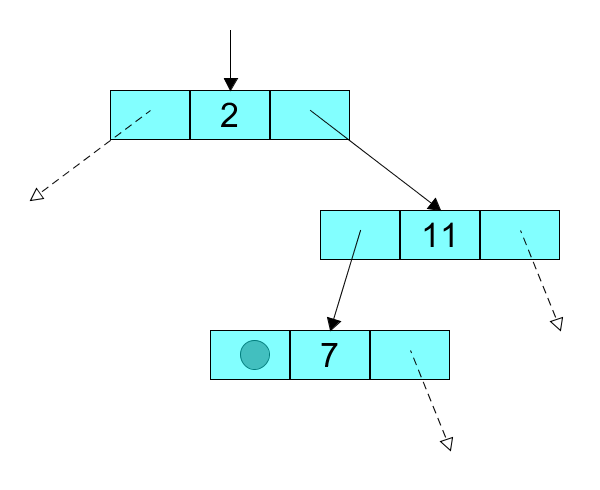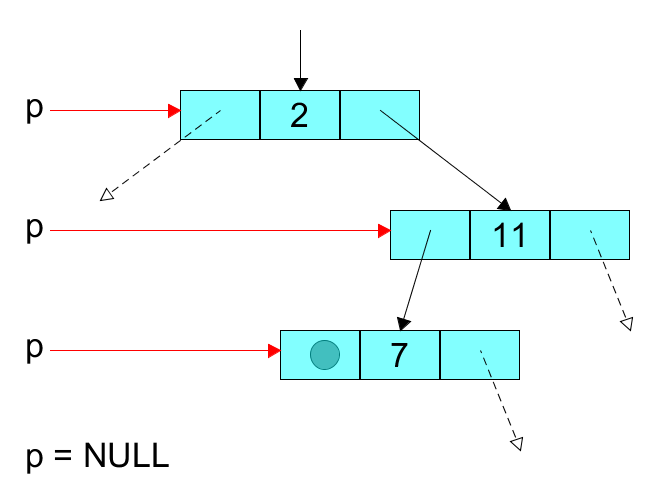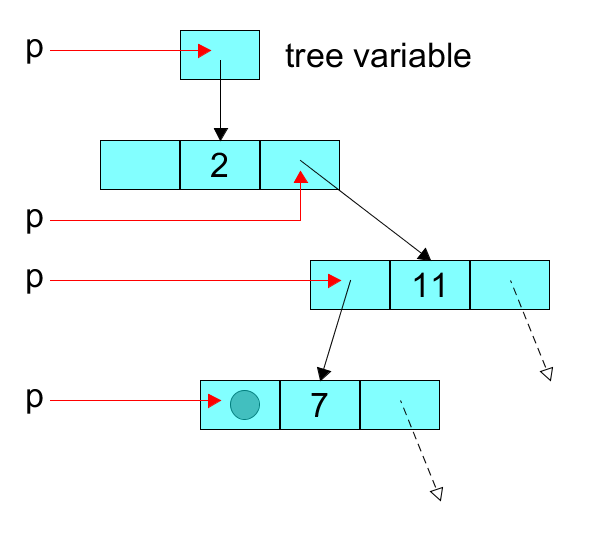

Suppose we want to search for things in a list
One possibility is to keep the items in a 'randomly' ordered list, so insertion is O(1), but then a search takes O(n) time
Or, we could keep them in a sorted list, in which case we can use a binary search which takes O(log(n)) time, but then new items would have to be added in the middle, which takes O(n) time
When there is a mixture of search and insert operations, and both operations need to be well below O(n), then the items can usefully be stored in an ordered binary tree
A tree is created out of cells, with each cell having two pointers
We will create ordered binary trees, without worrying about how well balanced the tree is
Balancing techniques include:
Here's a struct for holding one node in a tree of ints:
struct node {
struct node *left;
int key;
struct node *right;
};
typedef struct node node;
This is essentially the same as
Tree a = Tip | Node (Tree a) a (Tree a)
in Haskell (using NULL for Tip)
Here's a function to create a new node (a one-element tree):
node *new_node(int n) {
node *p = malloc(sizeof(node));
*p = (node) { NULL, n, NULL };
return p;
}
Here's a recursive insertion function:
node *insert_node(node *p, int n) {
if (p == NULL) p = new_node(n);
else if (n < p->key)
p->left = insert_node(p->left, n);
else if (n > p->key)
p->right = insert_node(p->right, n);
return p;
}
It uses p as a current-node variable
When you call it, it returns a possibly updated node, which you have to put back where you got it

Pointers are shown pointing to the 'middle' of nodes, but that's only for symmetry

Inserting 5, pointer p points to nodes, moves down
the nodes, ends as NULL
Here's a version which doesn't return anything, but uses a pointer to a pointer:
void insert_node(node **p, int n) {
if (*p == NULL) *p = new_node(n);
else if (n < (*p)->key)
insert_node(&(*p)->left, n);
else if (n > (*p)->key)
insert_node(&(*p)->right, n);
}
It updates in place, and only does it once
When we reach the right place, we have a pointer to NULL, so we can replace it

Now p points to a pointer, ends pointing to a box containing
NULL, and the box can be updated
Here's a complicated iterative version:
node *insert_node(node *p, int n) {
bool done = false;
if (p == NULL) { p = new_node(n); done = true; }
while (! done) {
if (n == p->key) done = true;
else if (n < p->key) {
if (p->left != NULL) p = p->left;
else { p->left = new_node(n); done = true; }
}
else {
if (p->right != NULL) p = p->right;
else { p->right = new_node(n); done = true; }
}
}
return p;
}
The structure is simpler using a pointer to a pointer:
void insert_node(node **p, int n) {
bool done = false;
while (! done) {
if (*p == NULL) {
*p = new_node(n); done = true;
}
else if (n == (*p)->key) done = true;
else if (n < (*p)->key) p = &(*p)->left;
else p = &(*p)->right;
}
}
Should you use recursive or iterative insertion, and should you use pointers-to-pointers or not?
You can disregard what anybody says about efficiency - what matters is complexity (and balance)
Use whichever you like - but when you write functions which use both left and right subtrees instead of just one, recursion stays simple while iteration gets nastier, and pointers-to-pointers are complex
So most programmers use recursion, and not pointers-to-pointers
Functions on trees are inconvenient if we force callers to use the nodes directly, either they have to catch the output (or pass a pointer-to-a-pointer)
So we need a wrapping structure for a tree:
struct tree {
struct node *root;
};
typedef struct tree tree;
This can also be a useful place to put global information about the tree
Here's a reasonable function to create a new tree:
tree *new_tree() {
tree *t = malloc(sizeof(tree));
t->root = NULL;
return t;
}
A wrapped insertion function is:
void insert(tree *t, int n) {
t->root = insert_node(t->root, n);
}
The insert_node function is the pointer-to-node recursive
version, but the user can't tell which version we are using
Searching is a bit simpler, and can also be done recursively or iteratively - here's a recursive version:
node *find_node(node *p, int n) {
if (p == NULL) { }
else if (n < p->key)
p = find_node(p->left, n);
else if (n > p->key)
p = find_node(p->right, n);
return p;
}
Here's an iterative version:
node *find_node(node *p, int n) {
bool done = false;
while (! done) {
if (p == NULL) done = true;
else if (n == p->key) done = true;
else if (n < p->key) p = p->left;
else p = p->right;
}
return p;
}
Again, we want a wrapper function
It shouldn't export any nodes to the user, it should just return (e.g.) a boolean to say whether the number is in the tree or not
bool contains(tree *t, int n) {
return find_node(t->root, n) != NULL;
}
A map is a structure which maps keys to values
For example, when counting words, you might want to map word strings as keys, to integer counts as values:
struct node {
struct node *left;
char word[20];
int count;
struct node *right;
};
The tree would be structured according to the words, and functions would retrieve or update the counts
There are many types of self-balancing tree, with red-black trees being the most popular in libraries because you only need one extra bit per node
The different types (AVL trees, 2-3 trees, ...) all use the same mechanism but have different policies
The mechanism used for balancing is rotation:

In both cases, A < P < B <
Q < C
Here's a function to rotate right:
node *rotate_right(node *q) {
node *p = q->left;
q->left = p->right;
p->right = q;
return p;
}
A policy is an algorithm which decides what rotations to do and when, according to some extra info in each node, and which guarantees O(log(n)) depth